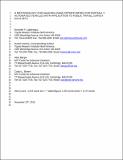| dc.contributor.author | Laberteaux, Kenneth P. | |
| dc.contributor.author | Hamza, Karim | |
| dc.contributor.author | Berger, Alan M | |
| dc.contributor.author | Brown, Casey L. | |
| dc.date.accessioned | 2020-03-17T17:44:21Z | |
| dc.date.available | 2020-03-17T17:44:21Z | |
| dc.date.issued | 2017-01 | |
| dc.identifier.issn | 0361-1981 | |
| dc.identifier.issn | 2169-4052 | |
| dc.identifier.uri | https://hdl.handle.net/1721.1/124147 | |
| dc.description.abstract | Vehicle automation has garnered a significant amount of interest in recent years. When the automated driving (AD) capability of a vehicle is assessed, it is important to distinguish between full automation, in which no human driver is required, and partial automation, in which a human driver may be required to intervene or take control of the vehicle occasionally for portions of the trip. This paper presents a method for assessing usage opportunities of partial AD in light-duty vehicle fleets. Key assumptions are that (a) the longer the time fraction of driving in which AD is active, the better, and (b) drivers will value having longer contiguous sections of AD-active time over having to frequently regain vehicle control. Given second-by-second records of real-world driving trips, the method uses a fuzzy inference system to estimate the fraction of driving time at a certain quality-of-use level. Performing the quality-of-use assessment for all trips and vehicles in a representative data set can then provide insight into the fraction of the population that would likely find partial AD desirable. To demonstrate the proposed method, data on vehicle trips from public travel surveys in California (California Household Travel Survey) and Atlanta, Georgia (Atlanta Regional Commission Travel Survey), were used along with simplified prototypical models for partial AD. Simulation results were generally in agreement with common perceptions but showed a wide range of possibilities, which could have been narrowed down further when more detailed trip data became available. | en_US |
| dc.language.iso | en | |
| dc.publisher | SAGE Publications | en_US |
| dc.relation.isversionof | http://dx.doi.org/10.3141/2625-05 | en_US |
| dc.rights | Creative Commons Attribution-Noncommercial-Share Alike | en_US |
| dc.rights.uri | http://creativecommons.org/licenses/by-nc-sa/4.0/ | en_US |
| dc.source | Prof. Berger via Jen Greenleaf | en_US |
| dc.title | Method for Gauging Usage Opportunities for Partially Automated Vehicles with Application to Public Travel Survey Data Sets | en_US |
| dc.type | Article | en_US |
| dc.identifier.citation | Laberteaux, Kenneth P. et al. "Method for Gauging Usage Opportunities for Partially Automated Vehicles with Application to Public Travel Survey Data Sets." Transportation Research Record 2625 (January 2017): 43–50 © 2017 SAGE Publications | en_US |
| dc.contributor.department | Massachusetts Institute of Technology. Department of Urban Studies and Planning | en_US |
| dc.relation.journal | Transportation Research Record | en_US |
| dc.eprint.version | Author's final manuscript | en_US |
| dc.type.uri | http://purl.org/eprint/type/JournalArticle | en_US |
| eprint.status | http://purl.org/eprint/status/PeerReviewed | en_US |
| dc.date.updated | 2020-03-10T13:13:57Z | |
| dspace.date.submission | 2020-03-10T13:13:59Z | |
| mit.journal.volume | 2625 | en_US |
| mit.journal.issue | 1 | en_US |
| mit.license | OPEN_ACCESS_POLICY | |
| mit.metadata.status | Complete | |
